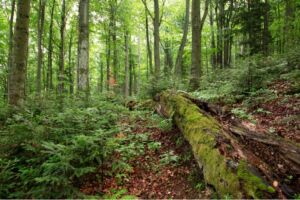The latest Science for Policy report, published in April 2021 by the JRC, the EC’s science and knowledge service, shows there are still primary and old-growth forests in Europe and calls for their mapping and strict protection. The report contributes to the aims of the European Green Deal and the Biodiversity Strategy to 2030 of strictly protecting all remaining primary and old-growth forests in the EU.
 Primary and old-growth forests are ecosystems where signs of past human use are absent or minimal and where ecological processes follow natural dynamics. They store and sequester carbon, provide fresh water, regulate the climate, and are home to a number of endangered species. Protecting these rare and unique forests is essential for biodiversity preservation and climate change mitigation.
Primary and old-growth forests are ecosystems where signs of past human use are absent or minimal and where ecological processes follow natural dynamics. They store and sequester carbon, provide fresh water, regulate the climate, and are home to a number of endangered species. Protecting these rare and unique forests is essential for biodiversity preservation and climate change mitigation.
According to the report, approximately 4.9 million hectares of the EU forests are primary or old-growth. These types of forest in the EU are small, fragmented, and increasingly rare, making up only 3% of the total EU’s forest area and only 1.2 % of the EU land. Moreover, their distribution is highly uneven: 90% of the EU primary and old-growth forests are located in Sweden, Bulgaria, Finland, and Romania.
The report calls for more robust and up-to-date mapping of primary and old-growth forests in the EU as a significant “mapping deficit” in some regions has been identified. The unmapped areas where the location of primary and old-growth forests is unknown amount to approximately 4.4 million hectares (that is more than a total area of the Netherlands).
The majority of mapped areas are already protected to some extent. About 93% of the EU’s primary and old-growth forests are part of the Natura 2000 network of protected areas, while 87% are ‘strictly protected. These figures should be considered with caution due to the mapping deficit and the unclear legal framework on what ‘strict protection’ means. Further mapping efforts are therefore necessary to comprehensively catalog primary and old-growth forests of the EU, which will require a strong collaboration of all involved parties, including landowners, nature conservation organizations, local and regional authorities, as well as the local communities.
This report presents an assessment of the knowledge and documented spatial data on primary and old-growth forests in the EU, as well as in some neighbouring countries. The EU’s biodiversity strategy to 2030 recognises the value of primary and old-growth forests, and calls for their strict protection.
This report provides a knowledge base contributing to the process of developing guidelines for the definition, mapping, monitoring and strictly protecting all the EU’s remaining primary and old-growth forests. This process is coordinated by the Working Group on Forest and Nature (sub-group of the Coordination Group on Biodiversity and Nature), which brings together representatives of the forestry and nature conservation national authorities and relevant stakeholders.
The following main conclusions are drawn:
Authors: Barredo Cano Jose Ignacio; Brailescu Cristina; Teller Anne; Sabatini Francesco Maria; Mauri Achille; Janouskova Klara
The full report is available here.
Digital for Planet - D4P © 2025 | All rights reserved